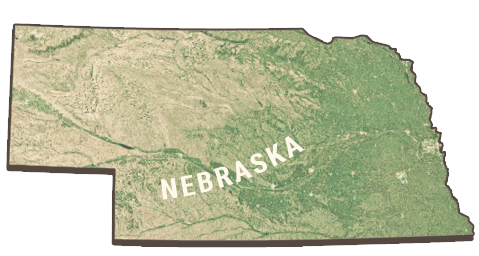
Shane Tucker follows in a long line of Nebraska paleo sleuths. He studied under Mike Voorhies, who studied under Morris Skinner, who studied under E.H. Barbour, who studied under O.C. Marsh. Mike Voorhies offers perspectives on his former student.
Shane Tucker has the unusual task of helping to identify and preserve fossils discovered in the course of excavations for Nebraska’s roads and highways. His primary responsibility is to monitor road construction projects across the state. He is on the watch for paleontological treasures amid the dirt and debris of excavation.
He must identify scientifically significant accumulations of fossils and collect or salvage them before, during, and after road excavations.
Since highway construction takes place all over the state, Tucker is likely to encounter all types and ages of fossils. Rather than specializing in one group of animals, he must be familiar with everything he may find, so his knowledge is quite broad.
Tucker is carrying on the work using all available means to make sure no clues are missed. Ideas about collecting specimens have changed. In the 1950's, paleontologists began to take a closer look not just at the big finds, but at the small clues to be found by sieving through the sediment in the area of a find. A paleontological screen is a tool that consists of wire mesh held in a frame. Dirt and debris are placed on top of the screen. Gently shaking the screen back and forth lets the finer sediment pass through the openings in the mesh, leaving behind bigger material that might include bone fragments, teeth, small jaws, and other significant specimens.
Tucker is heavily involved in educational outreach for the University of Nebraska-Lincoln. Across Nebraska, he serves as the face of the state museum.
For more than fifty years, the Nebraska Highway Paleontology Program has uncovered rich fossil finds, some as new as 20,000 years old, others dating back as far as 290 million years ago. Shane Tucker has been vitally active in the program, which has unearthed fossils in 91 of Nebraska’s 93 counties. Elephant and rhino bones have been collected, as well as shark teeth and remains of other creatures that once swam in the seas that covered Nebraska.
Shane Tucker has detected remains of a whole parade of different species in dirt piles, and excavation sites all over Nebraska.

Here is an Oreodont that Tucker collected:
Shane Tucker is not the first Nebraska paleontologist to collaborate with non-scientists to uncover and preserve the state¹s fossils. During the 1930's and 1940's, when America was in the throes of the Great Depression, the Works Progress Administration (WPA) funded many projects that put people to work. In Nebraska, one of those projects was a series of excavations under the supervision of paleontologists from the University of Nebraska State Museum.
The WPA field workers who excavated specimens were not fossil mammal experts, so they didn't know how to identify the animal bones. Workers placed the fossils in plaster field jackets and the specimens were transported to the museum to be examined, catalogued and added to the collections.
The digs yielded thousands of specimens from river, stream and water hole deposits of the Miocene (23 MYA to 5 MYA). The wealth of specimens made for decades of continuous preparation work as the jackets were opened and evaluated. The jackets contained hundreds of bones of animals, including Miocene camels, horses, rhinoceroses, carnivores, and more.
The specimens have helped fill in details about Miocene biochronology. In many cases the preparators opening the jackets found unexpected treasures inside.
For example, they were able to put together the skeleton of a wolf-like carnivore from the Amphicyonidae family, a fierce, fleet predator known as a beardog. Before the WPA specimens were prepared, only a few fragments of the beast had been found in the state. There are still many field jackets to open, and much more to find out about the Cenozoic fauna of Nebraska.